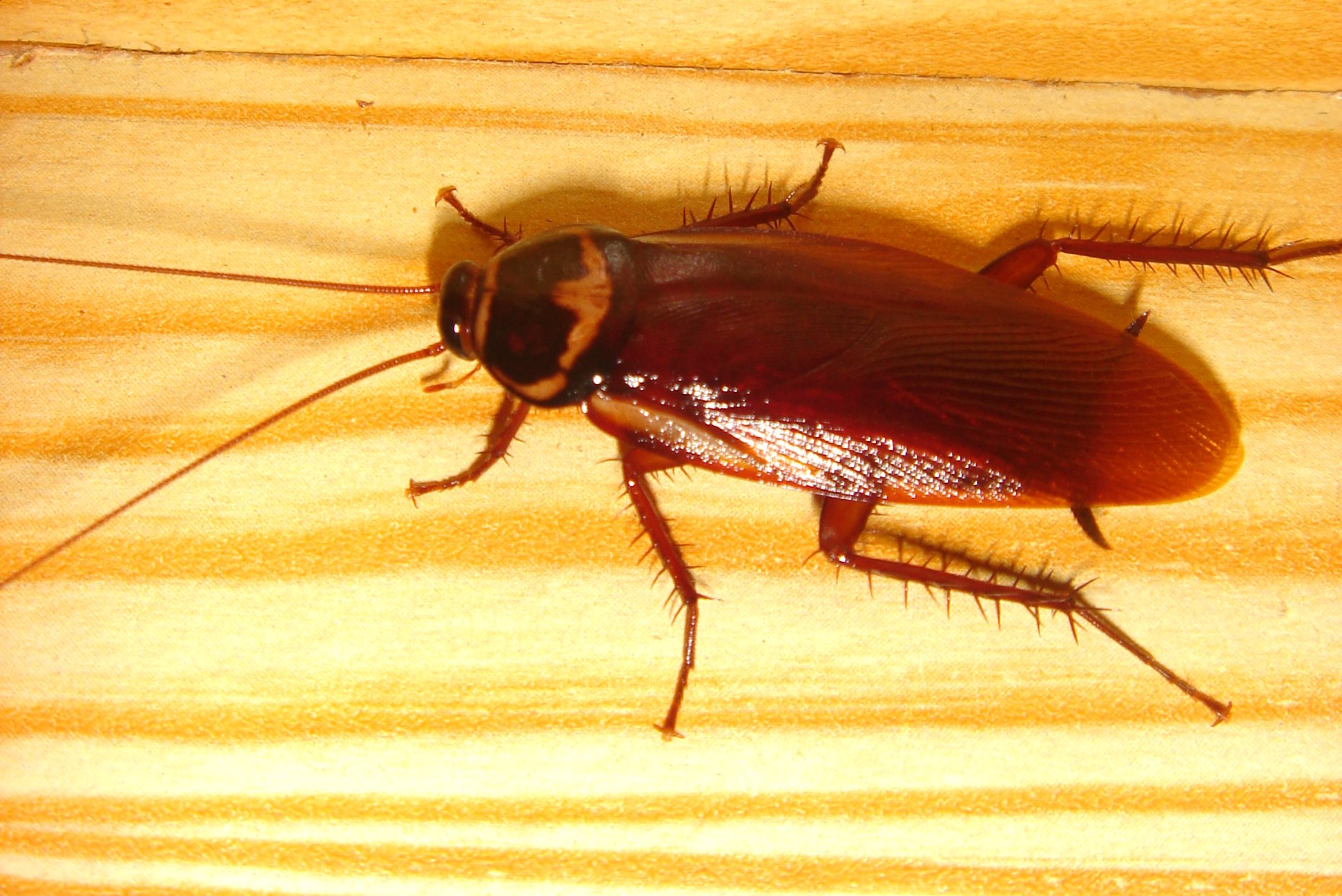Cockroaches

Common names: Cockroach, Roach, Water Bug, Palmetto Bug
Scientific name: Order Blattaria, family Blattidae
Size: Adult—1/4" to 1 3/4"
Identification: Brown, oval and flat-bodied. Antennae are long and slender. Very fast and active at night. Will occasionally fly. You know what they look like. The smaller roaches are German cockroaches; the larger ones are usually American cockroaches or palmetto bugs. Over 3,000 known species.
Biology and life cycle: Prefer warm, humid conditions. Feed at night on a wide variety of food. Hide in cracks, under floors, and other dark places during the day. They have an unpleasant odor.
Habitat: Cracks, crevices, cardboard boxes, chimneys, and other dark places that offer protection. Kitchen cabinets, chairs, and tables.
Feeding habits: Will eat any kind of food left accessible. They are attracted into houses for food crumbs and water.
Economic importance: Ruins food stuff. Most cockroaches live outside and help to decay organic matter. Believed to spread disease, but contrary to popular opinion, they rarely if ever spread human disease.
Natural control: Gecko lizards, scorpions, and beneficial nematodes. Freezing temperatures will kill some species.
Organic control: Boric acid products, baking soda soap, and sugar or molasses baits. Caulking the cracks, crevices, and holes in the house so the roaches can't walk right in is the first step in control.
Insight: All creatures were put on earth for a reason, even roaches. They are very important in the breakdown of organic matter. They also eat your food, books, and other possessions, poop all over the place, and may sometimes, although rarely, spread disease.
Howard's Roach Control Program
Roach control is a five-step process:
1. Exclusion. Keep them out of your house. Most roaches like it outside until they get hungry, can't find anything tasty there, and walk in through a house's holes or cracks to feast on the water and food crumbs left from dinner. To stop them, use caulking, steel wool, and copper mesh to fill the cracks in masonry, spaces between trim and brick, and holes of all kinds, including spaces around pipes. Put wire screens in air vents and stop up any other entryways.
2. Elimination of cracks. Fill cracks and crevices inside the house. One of the best weapons against roaches is the caulk gun. Every time you fill in a crack with caulk, you reduce the number of roaches that your home can support. Roaches will not mate unless they are nestled in the security of a very small space. A 1/8-inch-wide crack is too wide for roach comfort.
3. Removal of cardboard boxes. The honey-combed design of cardboard offers miles of tunnels that are perfect hiding and mating spaces; the glue on cardboard boxes and on paper sacks is attractive food for these critters.
4. Cleanliness. Eliminating food and water sources such as dripping faucets, leaks, pet water and food, and dirty kitchens makes your home much less attractive to roaches.
5. Baits. Once the roaches are in the house, there's a two-step attack. Boric acid dusted lightly where the bugs are seen is very effective, but use light dustings. If you can see the material after an application, so can the roaches--so you've put out too much. Diatomaceous earth products also work well. Effective homemade baits can be made by mixing one part sugar and one part Arm and Hammer detergent. A pinch of boric acid added to this mix makes it even more effective. This mixture has extremely low toxicity, but it still should be put in bait stations or lids and located in areas where pets and children can't get to them. Stronger baits can be made by mixing two parts flour, one part boric acid, and one part sugar and moistening enough to form little balls or cakes. Add more moisture from time to time to keep them more appetizing. Always keep all pesticides, even these organic home remedies, away from the pets and the kiddos.
Notes: Spray. The best organic sprays for roaches are the citrus products. Orange oil is the easiest to find and effective.
Control starts with thorough cleaning and the elimination of water and food in the house. Dust problem areas indoors with boric acid and/or natural diatomaceous earth. Put out baits indoors of 50% sugar and 50% Arm and Hammer laundry detergent. Use glass jars lids or other small containers. Apply beneficial nematodes to the grounds around the house and spray with plant oil products.
Roach Baits
1.
1 part Arm and Hammer laundry detergent
1 part sugar
Place the dry mix in bait stations.
2.
10 parts Arm and Hammer laundry detergent
10 parts sugar
1 part (or less) boric acid
Place the dry mix in bait stations.
For all baits, as stated above, always keep all pesticides, even these organic home remedies, away from the pets and children. It's best to use something that pets can't easily lick. Short pieces of a straw with one end taped shut or a piece of PVC pipe (1-2" diameter) with one end taped shut make good bait stations that can be taped to vertical surfaces. Commercial bait stations are available at feed stores and hardware stores.
For more information about boric acid, visit the National Pesticide Information Center: Boric Acid Fact Sheet and Boric Acid from Wikipedia.
Search Library Topics Search Newspaper Columns
